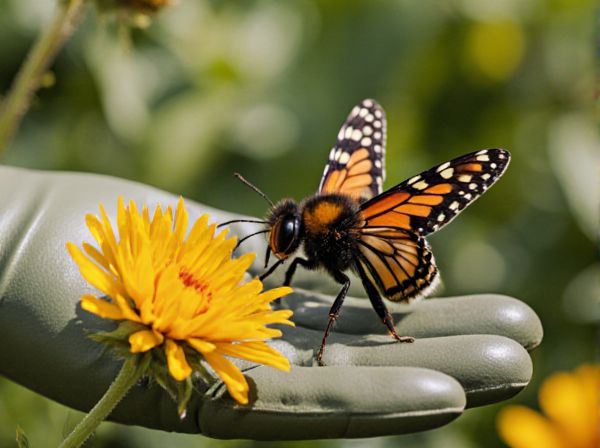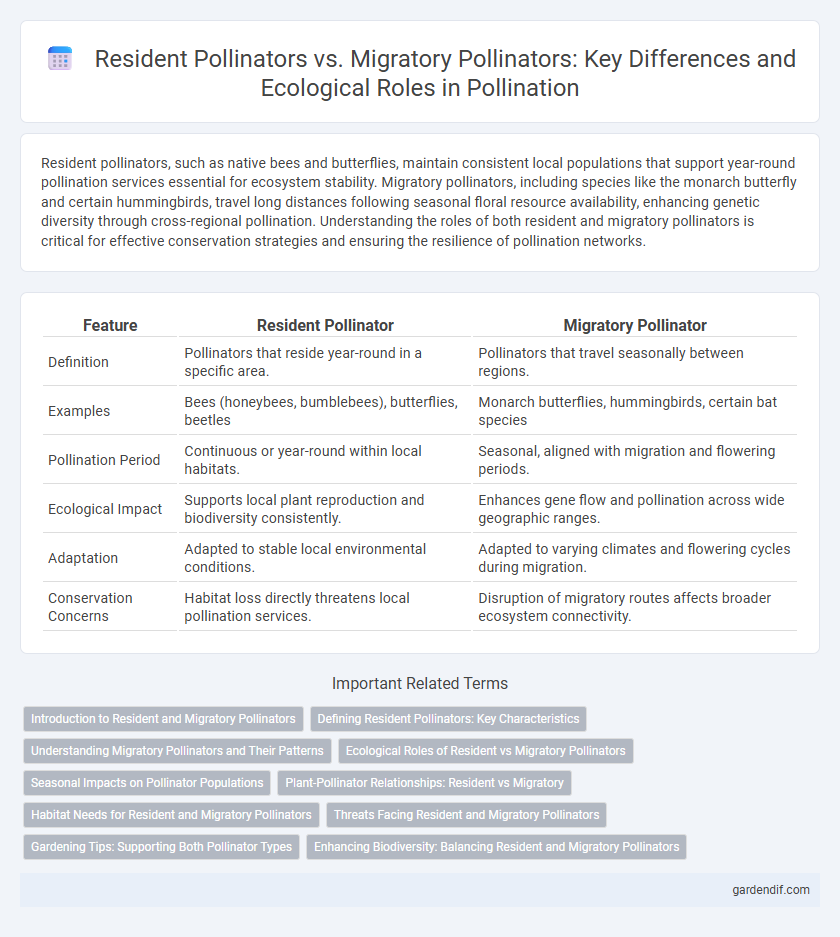
Resident pollinator vs Migratory pollinator Illustration
Resident pollinators, such as native bees and butterflies, maintain consistent local populations that support year-round pollination services essential for ecosystem stability. Migratory pollinators, including species like the monarch butterfly and certain hummingbirds, travel long distances following seasonal floral resource availability, enhancing genetic diversity through cross-regional pollination. Understanding the roles of both resident and migratory pollinators is critical for effective conservation strategies and ensuring the resilience of pollination networks.
Table of Comparison
| Feature | Resident Pollinator | Migratory Pollinator |
|---|---|---|
| Definition | Pollinators that reside year-round in a specific area. | Pollinators that travel seasonally between regions. |
| Examples | Bees (honeybees, bumblebees), butterflies, beetles | Monarch butterflies, hummingbirds, certain bat species |
| Pollination Period | Continuous or year-round within local habitats. | Seasonal, aligned with migration and flowering periods. |
| Ecological Impact | Supports local plant reproduction and biodiversity consistently. | Enhances gene flow and pollination across wide geographic ranges. |
| Adaptation | Adapted to stable local environmental conditions. | Adapted to varying climates and flowering cycles during migration. |
| Conservation Concerns | Habitat loss directly threatens local pollination services. | Disruption of migratory routes affects broader ecosystem connectivity. |
Introduction to Resident and Migratory Pollinators
Resident pollinators, such as native bees and butterflies, remain in a specific habitat year-round, playing a crucial role in local ecosystem stability and plant reproduction. Migratory pollinators, including monarch butterflies and certain hummingbird species, travel extensive distances seasonally, facilitating cross-regional gene flow and biodiversity. Understanding the distinct behaviors and ecological impacts of both resident and migratory pollinators is vital for conservation strategies and agricultural productivity.
Defining Resident Pollinators: Key Characteristics
Resident pollinators are species that remain within the same geographic area year-round, playing a crucial role in the continuous pollination of local flora. Key characteristics include territorial behavior, reliance on stable habitat resources, and adaptation to seasonal changes within their environment. Their consistent presence supports ecosystem stability and agricultural productivity by ensuring ongoing pollination even during periods when migratory species are absent.
Understanding Migratory Pollinators and Their Patterns
Migratory pollinators, such as monarch butterflies and certain hummingbird species, undertake long-distance journeys aligned with seasonal changes to access diverse floral resources. Their movement patterns are crucial for cross-regional plant pollination, enhancing genetic diversity and ecosystem resilience. Tracking these migratory routes using advanced tagging technologies reveals vital habitats and informs conservation strategies to protect both pollinators and the plants they support.
Ecological Roles of Resident vs Migratory Pollinators
Resident pollinators maintain local plant-pollinator networks year-round, supporting continuous reproduction of native flora and stabilizing ecosystem functions. Migratory pollinators contribute to genetic diversity by facilitating cross-regional pollen transfer and enhancing plant resilience across fragmented habitats. Together, these pollinator types ensure robust ecosystem services, balancing local stability with regional biodiversity connectivity.
Seasonal Impacts on Pollinator Populations
Resident pollinators maintain stable populations by continuously foraging within localized habitats, supporting consistent pollination services throughout the year. Migratory pollinators, such as certain butterfly and bee species, provide critical seasonal surges in pollination that coincide with flowering periods in diverse regions. Seasonal changes influence resource availability, directly affecting migratory routes and the population dynamics of both resident and migratory pollinators.
Plant-Pollinator Relationships: Resident vs Migratory
Resident pollinators maintain consistent interactions with local plant species, fostering stable plant-pollinator relationships critical for ecosystem resilience and biodiversity. Migratory pollinators, by contrast, contribute to genetic diversity and cross-regional pollination, facilitating plant gene flow over vast geographical areas. Understanding the complementary roles of resident and migratory pollinators enhances conservation strategies aimed at sustaining healthy plant communities and agricultural productivity.
Habitat Needs for Resident and Migratory Pollinators
Resident pollinators require stable, resource-rich habitats that provide continuous access to nectar, pollen, and nesting sites throughout the year, such as diverse wildflower meadows and undisturbed forests. Migratory pollinators depend on a network of habitats along their migratory routes, including flowering fields, wetlands, and resting areas that supply sequential blooming plants to sustain energy and breeding activities across seasons. Conservation efforts must consider habitat connectivity and temporal availability of floral resources to support the survival of both resident and migratory pollinator populations.
Threats Facing Resident and Migratory Pollinators
Resident pollinators face habitat loss, pesticide exposure, and climate change, which disrupt their localized foraging and nesting patterns, leading to population declines. Migratory pollinators encounter threats such as habitat fragmentation along migratory routes, adverse weather conditions, and scarcity of floral resources during long-distance travel. Both types are increasingly vulnerable to disease outbreaks and environmental pollutants, intensifying the risk of reduced biodiversity and pollination services.
Gardening Tips: Supporting Both Pollinator Types
To support resident pollinators like bumblebees and solitary bees, plant native flowering plants that bloom throughout the growing season, providing continuous nectar and pollen sources in your garden. Incorporate nesting habitats such as bee hotels, bare soil patches, and dead wood to encourage local pollinator populations to thrive. For migratory pollinators like monarch butterflies and hummingbirds, create nectar-rich flower corridors by planting milkweed and tubular flowers, ensuring they have essential food resources during their long-distance journeys.
Enhancing Biodiversity: Balancing Resident and Migratory Pollinators
Balancing resident and migratory pollinators is crucial for enhancing biodiversity, as resident pollinators provide consistent local pollination services while migratory pollinators introduce genetic diversity across regions. Integrating habitats that support the life cycles of both types ensures the resilience and stability of ecosystems. Effective conservation strategies prioritize native flora preservation and migratory corridors to maintain this dynamic pollination balance.
Resident pollinator vs Migratory pollinator Infographic

 gardendif.com
gardendif.com